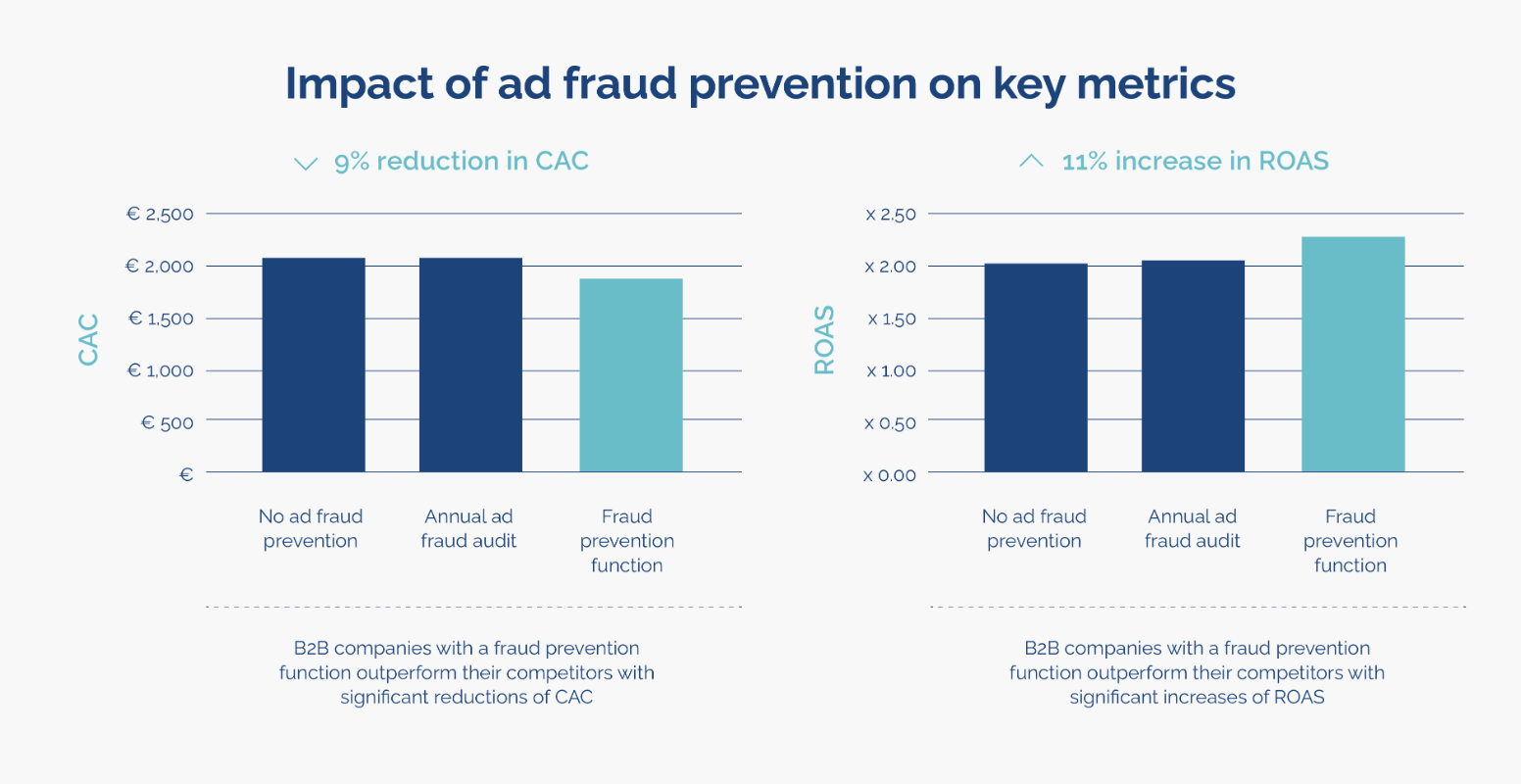The Impact of Ad Fraud on Marketing & How to Prevent It

 By
Eduardo Aznar
·
4 minute read
By
Eduardo Aznar
·
4 minute read
Ad fraud is a major problem for all marketers. As our Annual Ad Fraud Report reveals, it affects everyone. No country, business, or organization is fully free of its impacts. The damage is astronomical -- in fact, losses of $100 billion due to ad fraud are expected by 2023. Additionally, ignoring ad fraud limits marketers' ROAS by 11%.
Yet, most marketing teams are still not taking ad fraud seriously enough. And with ad fraud techniques becoming more sophisticated and widespread by the day, only dedicated efforts are truly effective to prevent ad fraud from affecting marketing performance.
Here, we’ll explore the real impact that ad fraud has on marketing, why the marketing function continues to ignore it, and how they can prevent it.
The truth about ad fraud’s impact on marketing
You want your ROAS -- how much is made on each dollar spent on campaigns -- to be as high as possible. You also want CAC rates -- costs incurred when acquiring new customers -- to be as low as possible.
But here are some sobering facts: Having no systems or processes in place to prevent ad fraud will reduce your ROAS by 11% while simultaneously increasing CAC by 9%.

It doesn’t matter which ad fraud technique scammers use: These seemingly small percentages have a huge impact on your bottom line.
And those aren’t the only colossal impacts on the marketing function.
Ad fraud drains ad budgets rapidly, which is of course a huge hindrance to marketers’ efforts. The more ad budgets are wasted on false leads and conversions, the less overall budget there is to spend on marketing efforts.
More importantly for marketers, digital ad fraud negatively affects spend optimization. Ad fraud can significantly skew campaign data, which results in inaccurate decisions being made with regard to future campaigns.
For example, ad fraud can cause high clickthrough rates coupled with minimal conversion rates. These types of “poor results” might prompt you to cancel a campaign, even though without ad fraud’s impact -- which in this case is usually caused by fraudulent clicks -- the campaign is actually performing well.
All this to say: Ad fraud continues to pose huge obstacles to the marketing function.
Yet, marketers continue to ignore ad fraud: And here’s why
When ad fraud is such a widespread problem, and its impacts are so damaging, why do most marketers generally continue to bury their heads in the sand and act as if it doesn’t exist?
Let’s take a look at some of the reasons why ad fraud isn’t being tackled head-on.
There’s a general lack of awareness about ad fraud
Firstly, many marketers either just aren’t aware that ad fraud exists, or how it directly affects the success of campaigns. With so many players in the digital advertising ecosystem, it becomes complex to identify the damage caused by ad fraud.
Some also think that ad fraud just doesn't affect their industry. Marketers trust their traffic channels and think ad fraud doesn’t affect their funnels. However, the performance marketing industry is based on impressions, clicks, and engagements such as leads, which can all be corrupted by ad fraud. Even though marketers don’t see the red flags, that doesn’t mean fraud is not lurking in the background.
Marketers have begun to accept ad fraud
Ad fraud has been around for years, and many marketing managers have simply accepted it as a cost of doing business. But since ad fraud can be avoided, this attitude often enables fraudsters to continue draining ad budgets.
There’s no budget left to fight ad fraud
Even if marketers know that something has to be done about ad fraud, they often feel like they don't have the budget for it. Amongst pressure to grow ad revenues, it may seem like a better option to just spend more money on ad campaigns or hire advertising specialists -- rather than investing in yet another SaaS tool.
However, with ad fraud draining $4.5 million every hour from organizations’ pockets and limiting ROAS by 11% on average, there are a few strategies that can boost results faster. Plus, with the availability of affordable anti-fraud solutions, it’s time to make the investment.
They haven’t taken into consideration the long-term impact on ROI
Fraud detection as a means to boost revenue has become part of the digital growth strategy. And ROI, or return on investment, is a crucial part of assessing the success of fraud operations. The broad term “fraud management” takes into account metrics like approval rates, complaint rates, and chargebacks. But accurately calculating ROI goes well beyond these numbers. Customer lifetime value (CLTV) should also be considered to assess traffic source quality, for example.
Their managers or clients are satisfied
Some marketers simply don’t want to stir the pot. So when their managers or clients are happy with the number of leads, clicks, or acquisitions being delivered, they tend to sit back and relax. Unfortunately, the amount of leads is not equivalent to qualitative business opportunities.
Sophisticated bots and human click farms are often behind well-performing affiliate channels. This leads to businesses experiencing short-term gains followed by long-term pains in the form of chargebacks or legal issues.
They don’t have the time to fight ad fraud
Between KPIs, business goals, and growth objectives, it’s commonplace for teams to claim that there’s no time to dedicate to the fight against ad fraud. Yet, when ad fraud is still ravaging campaigns, they will never achieve their true potential.
They work with in-house anti-fraud systems
Ad fraud hits big and small businesses alike, and in-house efforts have their pros and cons. The pros are that the system is tailored to the organization and can adapt according to its needs. The cons include extensive use of resources such as time, highly specialized employees, and budget. Using an in-house system can potentially not be as effective in tracking and blocking highly sophisticated fraud, as the famous Uber case revealed.
They don’t know how to stop ad fraud and lack the right tools & processes
Finally, even if marketers have the intention, budget, and time to fight ad fraud, they can be hindered from doing so by a lack of knowledge of the process and tools required. The following section should help with that.
How marketers can proactively prevent ad fraud
There are three things that marketing teams need to prevent ad fraud:
1) A fraud prevention process:
This process places the prevention of ad fraud at the core of a business and its growth strategy, combining resources, timings, and agendas to fight ad fraud efficiently. In essence, it aligns siloed systems, departments, and people to communicate and come together regularly to focus on a holistic strategy of preventing ad fraud.
2) A fraud prevention committee:
This is a group of individuals who oversee the prevention of ad fraud within a company. It typically includes representatives from marketing, sales, finance as well as growth and analytics teams. Since each of them has different insights into ad fraud indicators and all are affected by ad fraud eventually, it’s key for them to work and communicate together efficiently.
3) The organization of fraud prevention systems:
This involves the organization of the tools and solutions needed to fight ad fraud so that they work in harmony. They include an anti-fraud solution at the core and also a content management system, customer relationship management system, and analytics solution that feeds back additional data on ad fraud. To prevent fraud effectively, these need to be fully aligned.
To find out more about how Opticks’ solution can protect your organization from the threat of ad fraud, click here to request a free demo.
